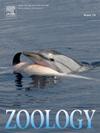Cranial variation across spiny pocket mice (Heteromys, Liomys) in new phylogenetic and taxonomic perspectives
IF 1.6
3区 生物学
Q2 ZOOLOGY
引用次数: 0
Abstract
Spiny pocket mice are usually divided into two genera, Heteromys and Liomys, and more recently the latter have been subsumed into the former, leaving subfamily Heteromyinae with one genus. However, this arrangement conveys false equivalency among heteromyines, and does not represent the great morphological, molecular, and ecological diversity in this subfamily. To address this, geometric morphometric methods were used to explore interspecific cranial variation in this subfamily, which were then evaluated in the context of recent phylogenetic and taxonomic findings. The dataset consisted of 65 landmarks on the crania of 328 adult voucher specimens (15 species, 114 localities). Allometry and habitat adaptation are potential explanations for some of the variation patterns. Morphometric clustering among some distant relatives suggests convergent adaptation to similar habitats. These results support recent taxonomic proposals for the subfamily based on molecular phylogenies, in which the three to four main lineages are assigned generic status. We summarize the evidence and describe their scaled cranial shape variation. These lineages consist of Heteromys as traditionally defined (i.e., not including Liomys) while the traditionally defined Liomys would be divided into the genera Schaeferia (S. adspersus + S. salvini), Liomys sensu stricto (L. irroratus), and potentially a fourth (new) undescribed/undiagnosed genus for L. pictus + L. spectabilis. The implications of the present study are that scaled cranial shape variation patterns align better with this modified taxonomy than earlier ones. Our results confirm the usefulness of geometric morphometrics in providing taxonomic insights in taxa that appear cryptic using traditional distance-based measurements.
从系统发育和分类的新角度看棘袋鼠(异鼠,异鼠)的颅骨变异。
带刺口袋鼠通常分为两属,Heteromys和Liomys,最近后者被归入前者,留下一个属的亚科Heteromyinae。然而,这种排列传达了异胺类之间的虚假等同,并不能代表该亚科中巨大的形态、分子和生态多样性。为了解决这个问题,几何形态计量学方法被用来探索该亚科的种间颅骨变异,然后在最近的系统发育和分类发现的背景下进行评估。该数据集包括328个成年凭证标本(15个物种,114个地点)的65个颅标。异速生长和生境适应是一些变异模式的潜在解释。一些远亲的形态聚类表明对相似生境的趋同适应。这些结果支持了最近基于分子系统发育的亚科分类学建议,其中三到四个主要谱系被赋予了一般地位。我们总结了证据,并描述了他们的尺度颅骨形状的变化。这些谱系由传统定义的Heteromys组成(即,不包括Liomys),而传统定义的Liomys将分为Schaeferia属(S. adspersus + S. salvini), Liomys sensu stricto (L. irroratus),以及可能的第四个(新)未描述/未诊断的属L. pictus + L。海棠。本研究的意义是,与早期的分类相比,颅骨形状的变化模式更符合这种改进的分类。我们的结果证实了几何形态计量学在使用传统的基于距离的测量方法提供类群的分类见解方面的有用性。
本文章由计算机程序翻译,如有差异,请以英文原文为准。
求助全文
约1分钟内获得全文
求助全文
来源期刊

Zoology
生物-动物学
CiteScore
3.90
自引率
0.00%
发文量
37
审稿时长
70 days
期刊介绍:
Zoology is a journal devoted to experimental and comparative animal science. It presents a common forum for all scientists who take an explicitly organism oriented and integrative approach to the study of animal form, function, development and evolution.
The journal invites papers that take a comparative or experimental approach to behavior and neurobiology, functional morphology, evolution and development, ecological physiology, and cell biology. Due to the increasing realization that animals exist only within a partnership with symbionts, Zoology encourages submissions of papers focused on the analysis of holobionts or metaorganisms as associations of the macroscopic host in synergistic interdependence with numerous microbial and eukaryotic species.
The editors and the editorial board are committed to presenting science at its best. The editorial team is regularly adjusting editorial practice to the ever changing field of animal biology.
 求助内容:
求助内容: 应助结果提醒方式:
应助结果提醒方式:


